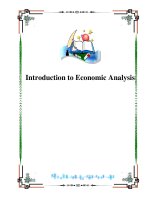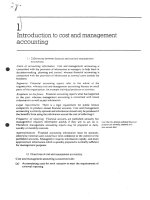Introduction to Economic and law
Bạn đang xem bản rút gọn của tài liệu. Xem và tải ngay bản đầy đủ của tài liệu tại đây (793.07 KB, 134 trang )
Economics and Law
CST part 1b
Ross Anderson, Richard Clayton
Why teach you this course?
• Modern systems involve many competing principals!
• Systems: Internet now so big it’s often more like a market
than a deterministic system! Economics used for protocol
design, congestion control, and much else
• Theory: the combinatorial auction is now seen as the
archetypal complexity-theory problem
• Professional: about half of you will eventually go into
consultancy, management, …
• Law: what can make you liable online?
• Ethics: how to navigate the many grey areas
• Policy: arguments about copyright, surveillance, privacy…
Aims and Objectives
• Aims: introduce you to some basic concepts in
economics and law
• Objectives: at the end, you should have a basic
appreciation of economic and legal terminology
and arguments; understand some of the
applications of economic models to systems
engineering and their interest to theoretical
computer science; and understand the main
constraints that markets and legislation place on
firms dealing in information goods and services
Outline
• Game theory: prisoners’ dilemma, iterated games
• Classical economics with competitive markets
• Market failures – monopoly, asymmetric
information, network effects, lock-in
• How information markets are different
• Auction theory and mechanism design
• Principles of law – contract, tort and other ways
you can become liable for things you do online
• Law and the Internet
• Policy and ethics
Resources
• Shapiro and Varian “Information Rules”
• Varian “Intermediate Microeconomics”
• Course website, plus as further reading:
Adam Smith, “The Wealth of Nations”
JK Galbraith, “A History of Economics”
Len Fisher, “Rock, Paper, Scissors”
William Poundstone, “Prisoners’ Dilemma”
Paul Seabright, “The Company of Strangers: A Natural
History of Economic Life”
– Paul Krugman, “The Return of Depression Economics”
– Glanville Williams, ATH Smith, “Learning the Law”
–
–
–
–
–
Studying a humanities subject
• It’s not like learning to prove theorems or
program in Java, which gives a testable skill
• Wide reading is important – ideas become clearer
when approached from several perspectives
• College libraries are a good place to start
• Dig into some subproblem that interests you
• Work out opposing viewpoints: how would a
socialist / libertarian / Keynsian / monetarist
approach this problem? What decides if people
cooperate or compete, what resolves conflict?
• Write proper essays!
Roadmap
• Economics as a subject is traditionally made up of
macroeconomics, microeconomics and specialised
topics
• ‘Macro’ is about the performance and structure of
the global economy or a nation or region. It’s
about models of employment, inflation, growth,
investment, savings, credit, tax, GNP…
• We will touch on this only briefly
Roadmap (2)
• Microeconomics or ‘micro’ is about how
individuals and firms react to incentives, how
market mechanisms establish prices, and the
circumstances in which markets can fail
• Many topics of interest to computer scientists &
engineers include game theory, the economics of
information, the economics of dependability, and
behavioural economics (economics + psychology)
• Our tools range from mathematical models to
empirical social science
Cooperation or conflict
• One way of getting what you want is to make it,
or make something else of value and trade for it –
‘Economics’
• Another way is to just take it, whether by force or
via the ballot box – ‘Politics’
• Choices between cooperation and conflict are
made at all sorts of levels all the time
• They can evolve in complex combinations
• The tool we use to tease them out and analyse
them is game theory
Game theory
• The study of problems of cooperation and conflict
among independent decision-makers
• We focus on games of strategy, rather than chance
• We abstract to players, choices, payoffs, strategies
• There are
– games of perfect information (such as chess)
– games of imperfect information (which are often more
interesting to analyse)
Strategic form
• Example: matching pennies. Alice and Bob throw
H or T. If they’re different, Alice gets Bob’s
penny; else he gets hers. The strategic form is
Bob
H
T
Alice
H
-1, 1
1, -1
T
1, -1
-1, 1
• This is an example of a zero-sum game: Alice’s
gain = Bob’s loss
Dominant strategy equlibrium
• In the following game, Bob’s better off playing left;
similarly Alice is always better off playing bottom
Bob
Left
Right
Alice
Top
1, 2
0, 1
Bottom
2, 1
1, 0
• A strategy is an algorithm: input state, output play
• Here, each player’s optimal play is a constant
• The is called a ‘dominant strategy equilibrium’
Nash equlibrium
• Consider this game:
Alice
Bob
Left
Right
Top
2, 1
0,0
Bottom
0,0
1,2
• Each player’s optimal strategy depends on what they think the
other will do
• Two strategies are in Nash equilibrium when A’s choice is
optimal given B’s, and vice versa
• Here there are two: top left and bottom right
• This game is sometimes called ‘Battle of the sexes’
Pure v mixed strategies
•
If we allow only deterministic algorithms, some games have no Nash
equilibrium. E.g.
Bob
Alice
•
•
scissors
paper
stone
scissors
paper
stone
0
-1, 1
1, -1
1, -1
0
-1, 1
-1, 1
1, -1
0
Alice plays scissors → Bob wants to play stone → Alice wants to play
paper …
Fix: randomised algorithm. This is called a ‘mixed’ strategy;
deterministic algorithms are called ‘pure’
Prisoners’ dilemma
• Two prisoners are arrested on suspicion of planning a robbery.
The police tell them separately: if neither confesses, one year
each for gun possession; if one confesses he goes free and the
other gets 6 years; if both confess then each will get 3 years
Benjy
Alfie
confess
deny
confess
deny
-3, -3
-6, 0
0, -6
-1, -1
• (confess, confess) is the dominant strategy equilibrium
• It’s obviously not optimal for the villains!
• Is this a problem? If so, what’s the solution?
Prisoners’ dilemma (2)
• You might answer ‘serves them right’!
• But this can’t apply to all instances of the dilemma
–
–
–
–
–
Defence spending
Fishing quotas
Free riders in file-sharing systems
Reducing carbon emissions
…
• Tough but inescapable conclusion: if the game is
truly as described, there is no escape. Both will
cheat rather than cooperate, with bad outcome
• To fix it, you need to change the game somehow!
The evolution of cooperation
• If PD played repeatedly, there’s a fix!
• ‘Tit-for tat’: cooperate at round 1, then at round n do
what the other guy did at n-1
• Large simulation competitions run by Bob Axelrod
played off many iterated-game strategies; tit-for-tat
did consistently well
• In the presence of noise, tit-for-tat gets locked into
(defect, defect). So: forgive the other guy
occasionally
• People have realised in the last 20 years or so that
strategy evolution explains a lot of behaviour
Price-fixing
• If it costs $250 to fly someone LHR-JFK and
back, do airlines compete and charge $255 or
collude and charge $500?
• Competition laws forbid price-fixing cartels, but
the same behaviour can arise implicitly
• Try charging $500 and see what other airlines do.
If they ‘defect’ by competing, play tit-for-tat
• If you’re the regulator, how do you cope?
Stag hunt
• People can hunt rabbits on their own, but have to work together
to hunt a stag. If your buddy runs off after a rabbit, the stag will
escape
Frank
Bernard
chase hare
hunt stag
chase hare
hunt stag
2, 2
0, 5
5, 0
10, 10
• Difference from PD: (stag, stag) is now a Nash equilibrium
• You’ll only chase a rabbit if you believe your buddy will defect
• Thus while PD is payoff-dominant, stag hunt is risk-dominant
Chicken
• In ‘Rebel without a cause’, Jim (James Dean) and Buzz (Corey
Allan) drive stolen cars at a canyon and try to jump out last to
prove their manhood
Jim
jump
drive on
Buzz
jump
2, 2
1, 3
drive on
3, 1
0, 0
• Here, (1,3) and (3,1) are Nash equilibria
• Bertrand Russell suggested this as a model of nuclear
confrontation in the Cold War
• Biologists call the iterated version hawk-dove (more later)
Volunteer’s dilemma
• Multi-player chicken: if one person volunteers, everyone else
benefits, but if no-one volunteers then everyone suffers a big
loss
Everyone else
someone acts
no-one acts
Me
act
benefit - cost
benefit - cost
Don’t act
benefit
big loss
• The Arab Spring is harder still: “If everyone goes on the street
and says ‘the government is finished’, it’s finished. If you go on
the street and say ‘the government is finished’, you’re finished”
• Evolution of leadership: first move = fitness signal
Deadlock
• Differs from PD in that (defect, defect) is preferable to mutual
cooperation.
Alice
Bob
cooperate
defect
cooperate
1, 1
0, 3
defect
3, 0
2, 2
• That is, I’m going to defect anyway but it would be nice if you
were a sucker and cooperated
• Is mutual defection a dominant strategy equilibrium, or a Nash
equilibrium?
Asymmetric games
• In the game of ‘Bully’, the first player plays chicken while the
second plays deadlock
Deadlock player
Chicken player
cooperate
defect
cooperate
2, 1
1, 3
defect
3, 0
0, 2
• Example: the ‘Wisdom of Solomon’
• The baby’s real mother plays chicken (rather see the baby live)
while the thief plays deadlock (rather not lose)
• (Depressing) model of military aggression
Game theory and evolution
• John Maynard Smith proposed the ‘Hawk-dove’ game as a
simple model of animal behaviour. Consider a mixed population
of aggressive and docile individuals:
Hawk
Dove
Hawk
(v-c)/2, (v-c)/2
v, 0
Dove
0, v
v/2, v/2
• Food v at each round; doves share; hawks take food from doves;
hawks fight (with risk of death c)
• If v > c, whole population becomes hawk (dominant strategy)
• What happens if c > v?
Game theory and evolution (2)
• If c > v, a small number of hawks will prosper as most
interactions will be with doves. Equilibrium reached at hawk
probability p setting hawk payoff = dove payoff
Hawk
Dove
Hawk
(v-c)/2, (v-c)/2
v, 0
Dove
0, v
v/2, v/2
• I.e. p(v-c)/2 + (1-p)v = (1-p)v/2
⇔ pv - pc+ 2v -2pv = v - pv
⇔ -pc = -v
⇔ p = v/c









